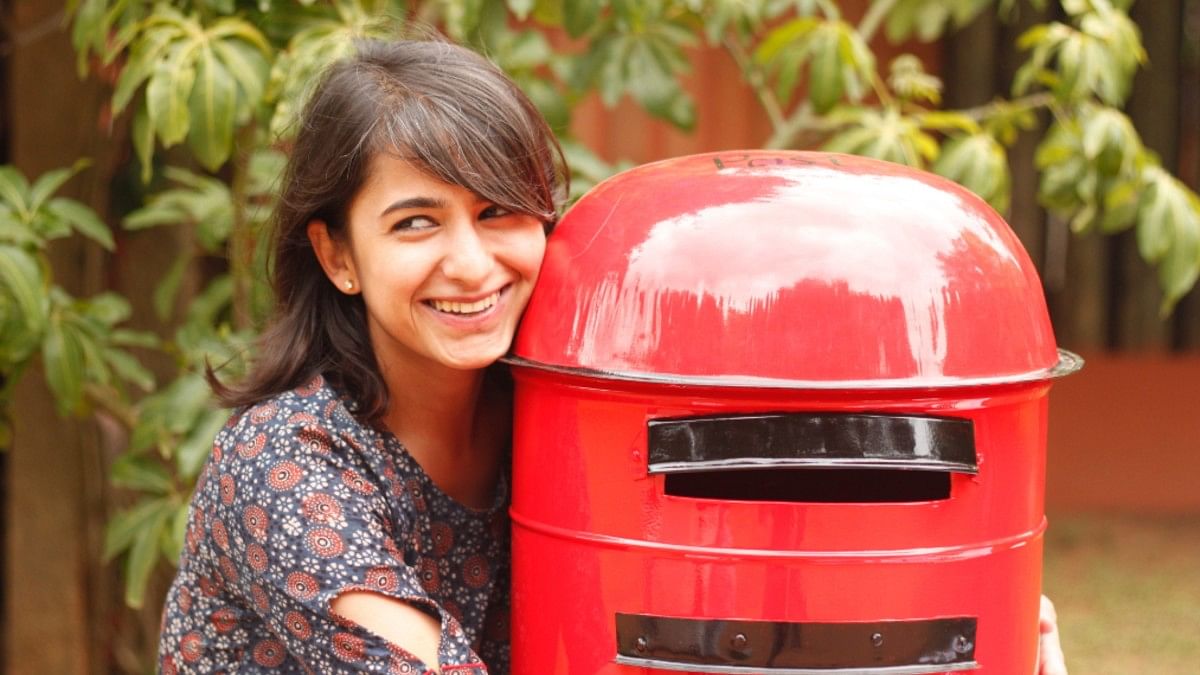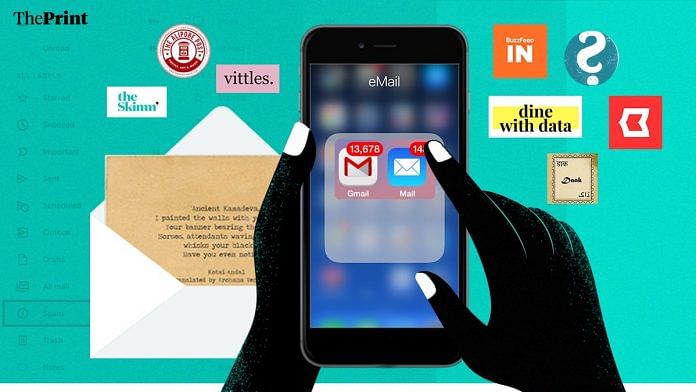From poetry to business and market data, from queer views to viral videos, art recommendations to adulting blues, there is a deftly curated newsletter with ‘just you’ in mind, waiting in your inbox. And you thought only news organisations are sending you daily newsletters? India’s newsletter ninjas are leading a silent, but growing media revolution right under our Covid-masked noses.
Mush, Dine with Data, Splainer, Daak Vaak, and The Alipore Post are some of the new newsletters in this growing subculture that is thumbing their noses at not just traditional media, but also at the oversharing social media universe. ‘The email is dead’ was one of the premature declarations that began a decade ago. Today, your precious mailing list is the new power accessory in this subculture.
The inbox influencers
It takes my browser 0.52 seconds to cough up 11,40,00,000 results when I Google ‘Newsletter + Spam’ — advice ranging from how to declutter your inbox from too many newsletters, to tips on rescuing your favourite ones from getting lost in junk mail. Although newsletters might have become synonymous with those annoying emails you get from banks, travel agencies, or that website you once bought shoes from, they’re the new form of literary and creative self-expression during Covid-19.
The burgeoning scene now boasts on newsletters about everything. If you have an interest and an interest group, there is a newsletter out there that will speak directly to you. From LGBTQ+ issues, policy, financial news, food, to law, they not only ensure privacy and non-linear reading, but now can also earn you money. From Rega Jha to Veer Misra and Lakshmi Chaudhary, the future influencers won’t just be on Twitter, Facebook or Instagram, but in your inboxes, too.

Newsletters also disrupt traditional economic models, giving a chance to writers and editors to directly monetise their independent work. Just like India’s slow but steady podcast boom, it’s all about leaning in and paying attention — who knows which one might become the next big thing. After all, Hollywood actor Gwenyth Paltrow’s hobby newsletter of curated recommendations went on to become the $250 million wellness empire, Goop.
Some of the best Indian newsletters are currently free to access. Some cost a small monthly or yearly fee. Some offer you deep dive personal essays, pop culture critiques, aggregated news roundups, or serve as a window into the work of your favourite people on the internet — a direct line to environmentalists, activists, authors, literary translators and journalists.
But they all do have one thing in common — they’re here to save you from the sea of the internet, especially those 50 plus tabs on your browser that won’t stop piling up.
Also read: Simple, fun, democratic — why Microsoft Paintbrush was more than just a graphics tool
A reprieve from the internet, on the internet
Newsletters are not only an alternative mode of delivering content, but also nurture stories drowned out by the din of the mainstream. For 24-year-old graphic designer Veer Misra, the pandemic presented an opportunity to fill a the void he always felt in queer story telling — “the softer, cosier side of our experiences” that gets lost in either the political or stereotypical conversations around being LGBTQ+ in India. So, he started mush, a fortnightly newsletter that puts together tender long-form essays about identity, love and desire, because “the most interesting queer stories worth telling are about what happens after the coming-out stage”.
Veer was attracted to the privacy it affords. “I’m hoping my newsletter can be read by 15 or 16-year-olds, who might not want to be seen visibly reading or subscribing to a website. A newsletter is more private and personal, like a safe digital space.”
Like a world unto itself, newsletters are steeped in interesting subcultures, and are handpicked by readers. Gurgaon-based advertising professional Banda Mann Singh Lamba subscribes to ones that give him a daily dose of creativity and inspiration such as the Ken and WhatsApp newsletter Dine with Data, which provide crisp updates on the worlds of business, startups and various creative industries. “Instead of looking around for information, I try to choose newsletters that can give me ideas in my inbox everyday”. When he has some free time at work, he reads the popular news roundup product Splainer, as it feels like a “mental break”.
This, as Firstpost and Splainer’s founder Lakshmi Choudhary explains, is by design. With a colourful illustration-filled interface, aided by the website’s mascot dog that takes you through sections such as “sanity break”, “the feel good place”, the newsletter-cum-website is filled with interesting stories, viral videos from the internet that contribute to a “warm, non-stressful” virtual environment, breaking away from a traditional news format. The idea is to “turn down the volume”, both in terms of the amount of content available on the internet, and the headline-grabbing, shouting-anchor ecosystem we’ve become accustomed to, explains Chaudhry.
This explains why each of mush’s editor notes ends with a reminder to absorb and enjoy each issue at one’s own pace — “slow down and take as much time as you need, we’re not going anywhere, we promise”.
‘Slow’ is truly the operative word, as suggested by the metaphor of letter writing that is championed by two distinct, but wonderful poetry newsletters — Daak Vaak and The Alipore Post.
When an email with the subject line ‘You’ve got Daak’ pops into your inbox every week, you can expect a beautifully designed virtual postcard featuring the 19th century Bengali artist Sunayini Devi’s paintings, or classical Tamil poetry by the 9th century saint, Kotai Andal. Started by anthropologist Onaiza Drabu and educator Prachi Jha, Daak Vaak is “an evocation of all that we’ve lost in this digital age with regard to slow letter writing”. They explain that their project is a special effort in trying to share poetry, art and literary references from across different Indian regions and languages, an attempt to “dig out treasures from the subcontinent’s attic”.

It was with a similar intention that Bengaluru-based marketing professional Rohini Kejriwal began The Alipore Post. What started off as daily emails packed with loving recommendations to her friends in 2015, soon turned into painstakingly curated “letters to the internet”, replete with crowdsourced contemporary poetry, essays, illustrations, and curios from the internet, showcasing a range of young Indian names. Having garnered a social media following of more than 30,000 followers over the years, Kejriwal has built a close-knit community. She has even hosted offline events where artists have displayed and sold their works and, of course, written actual letters.

Even for Daak, with an impressive social media presence of 60,000 followers, the emphasis is on building a relationship with subscribers. As Jha explains, “To me, reading a regular newsletter feels very much like cultivating a friendship”.
Also read: How Instagram went from hipster favourite app to must-have by Pepsi, Playboy and Snoop Dogg
Not just a side hustle
When American culture writer Anne Helen Peterson, author of viral stories like How Millennials Became The Burnout Generation, announced her departure from Buzzfeed in August, many bated their breath to see which global publication she would join next. But surprisingly, she shared plans of focusing full-time on her Substack newsletter.
Once considered only to be creative weekend projects, the pandemic has accelerated the status of newsletters to being viable sources of income. Most, like The Alipore Post, have till now been available for free, although Rohini Kejriwal now gives subscribers an option to voluntarily contribute to her Patreon account. But considering the broken economics of traditional media, writers and editors are beginning to contemplate the idea of directly monetising their independent writing and reporting work.
Former Buzzfeed India chief and social media darling Rega Jha started her own weekly newsletter last month — “first drafts of thoughts and feelings” about mental health, web culture, gender and adulthood. She explained to her 100,000 plus Instagram followers that charging a sum of Rs 900 for six months would help her make a basic living during a time when journalism budgets have shrunk. Freelancers are translating their personal brands into direct income. “If you’ve spent 10-15 years building up your profile and your work, that is the safety net. There is no other safety net today,” says Lakshmi Chaudhry.
WhatsApp groups of Indian freelance reporters have lately been filled with questions and debates around monetising one’s personal work this way, says Delhi-based independent writer Sharanya Deepak. “Most Indian journalists are so used to working for someone else that most can’t wrap their head around the fact that they can write or report about what they want and make money off it, without having to heckle editors with pitches and chase them for payments”.
Her own experience of contributing to Vittles, an indie British food media newsletter, was pleasant — she was paid on time, the correspondence was smooth and professional, despite the fact that the newsletter is run by a one-man army. Her recent essay on the bustling Northeast food scene in New Delhi’s Humayunpur enclave was also shared on Splainer — “My dad is an avid reader, he was beaming when he came across a mention of my article”.
Shout-outs of this kind are a part and parcel of newsletter culture, where there is constant sharing of links to people’s work, and recommendations to other newsletters. A group even made the effort to compile a growing directory of Indian newsletters.
“It’s a small ecosystem and it’s important to nurture each other’s work,” explains Rohini.
Also read: Do-piyaza, blood-spitting paan, camels — The ‘bizarre’ food of Mughals in Western travelogues
Why readers matter
“Everyone and their mothers are doing newsletters now,” remarks Lakshmi Chaudhry, who had to close operations for her newsletter Broadsheet at the beginning of the Covid-19 lockdown. It was meant to be an Indian version of The Skimm, a comprehensive daily news explainer created by women and for women — a demographic that is known to conventionally consume less news than men. But almost 35 per cent of their audience ended up being men, proving that a well-created product would have all kinds of takers. Her second innings with Splainer, launched in June, is armed with an actual business model — a yearly subscription model of Rs 1,000 — and a strong focus on user experience — “It no longer looks like a newsletter, it’s got more of a magazine-y feel”.
Her approach personifies her readers. “How do you make sure people want to continue reading you? They might be exhausted, or have recently suffered a 50 per cent pay cut, or are struggling with 10 other things,” she says, explaining her conscious effort to not overwhelm readers with news of the world’s sordid state of affairs.
Convincing readers to pay for their content is one task, making them not hit the unsubscribe button is another challenge altogether. Unlike social media, newsletter is not a sheer numbers game but is more about understanding the difference between high traffic and virtuous traffic.
While Misra plans to address this by letting his audiences and contributors be equally in control of the direction of mush, Kejriwal tries to account for reader feedback about frequency and content of The Alipore Post.
As some critics will point out, it is probably not possible for all newsletters to scale up and survive financially — there are just so many of them. In the end, the ones that will endure will be those with the most loyal subscribers. Chaudhry is beginning to get a taste of what this could feel like, given the kind of shout-outs and love Splainer has received in its three-month run — “never in my 20-year career have I ever been thanked for doing my job, and it feels great.”
Views are personal.




I am interested
I am very interested